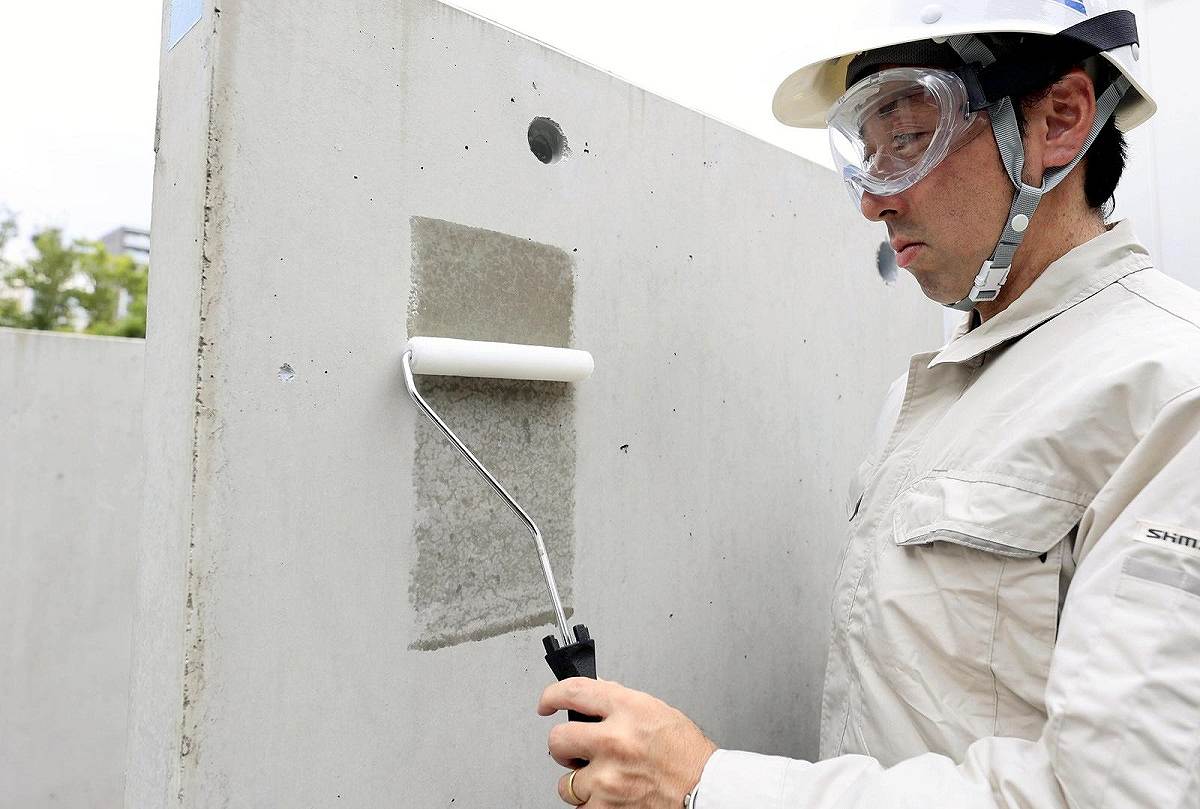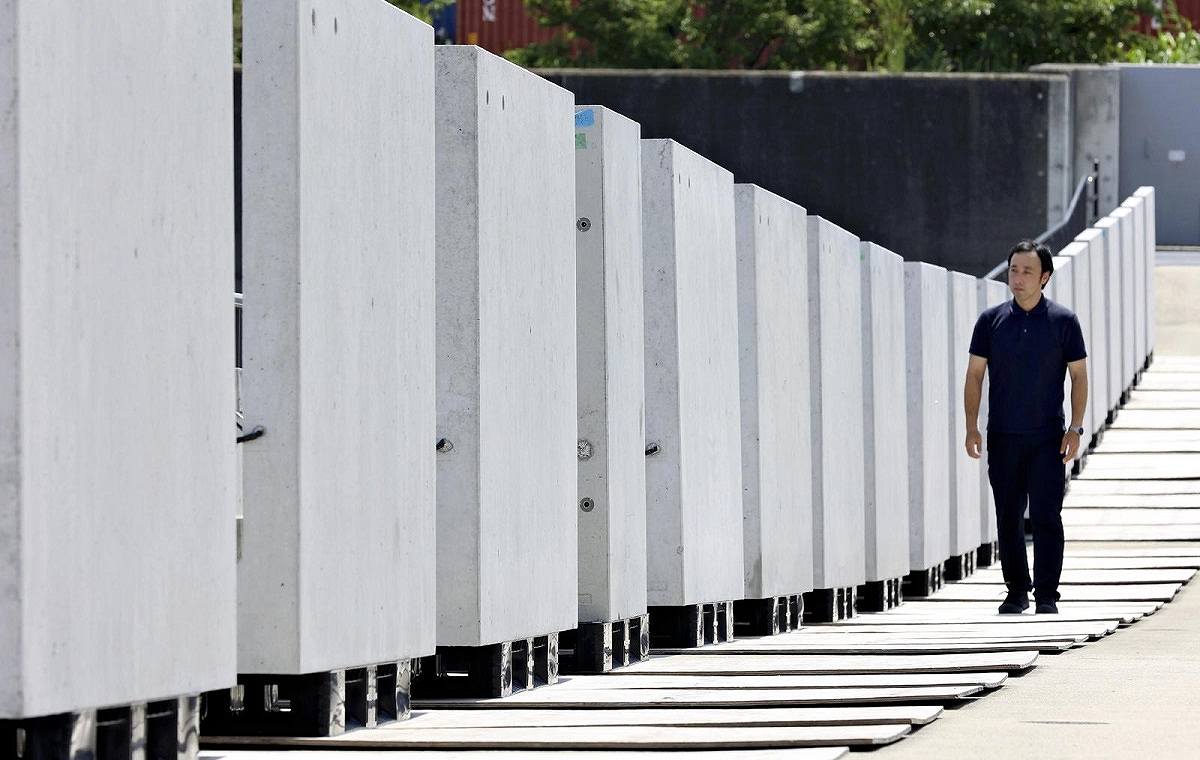CO2 Capture Technologies Advancing with Eye on Climate Change; New Technologies Include Absorption Coating Compound for Concrete

A worker tests a coating compound that absorbs carbon dioxide on a concrete wall in Koto Ward, Tokyo, on Aug. 21.
1:00 JST, October 20, 2024
Amid worsening abnormal weather associated with global warming and climate change, including torrential rain and high temperatures, the development and application of various carbon dioxide capture technologies is progressing.
CO2 emissions are one of the main drivers of global warming. Since some of these CO2 capture technologies do not require large-scale equipment, they may become well-known fixtures in Japan in the not-too-distant future.

Concrete walls coated with a compound that absorbs carbon dioxide in Koto Ward, Tokyo, on Aug. 21
Coating ‘concrete jungles’
A coating compound that absorbs CO2 has been jointly developed by Shimizu Corp. and Hokkaido University. The compound has been applied to more than 50 concrete slabs over a sluice gate in the Tokyo Bay area in Koto Ward, Tokyo.
The amine-based compound absorbs CO2 from the air and confines it in the concrete semi-permanently. The compound can be applied to existing buildings, bridges and expressways. The amount of CO2 absorbed by 10 bridge piers coated with it is roughly equivalent to that absorbed by planting one hectare of artificial cedar forest.
The amine compound, which also adds corrosion resistance, is expected to improve the durability of the rebar in structures, too.
Concrete, an essential construction material, emits large amounts of CO2 during production. Shimizu has long been working on ways to reduce these emissions. With subsidies granted from the Tokyo metropolitan government in February, the company has been conducting experiments to improve the performance and durability of the coating compound, aiming to put it into practical use in 2026.
“In the future, it may be possible to buy the compound at a home improvement store and use it at one’s home. I hope the concrete jungles will absorb CO2 like real jungles,” said Ryosuke Saito, a researcher at the company’s Institute of Technology.
Rising global temperatures
Technology that artificially captures CO2 in the atmosphere is called direct air capture (DAC). Global companies and research institutions have been conducting various experiments with such technologies. The absorbed CO2 can be mixed with concrete as a construction material or with soil to promote the growth of plants.
DAC is garnering attention partly because increases in CO2 and other greenhouse gas emissions show no signs of stopping.
The 2015 Paris Agreement, an international framework to address climate change, set the target of containing global temperatures at 1.5 C above preindustrial levels. However, according to the Copernicus Climate Change Service, the European Union’s meteorological agency, the global average temperature was 16.82 C in August matching last year’s figure, which was the highest since observations began in 1940.
According to the Japan Meteorological Agency, Japan this year matched its 2023 record for the hottest June-August period since comparable data became available in 1898.
Although countries set their own CO2 reduction targets, few have been able to achieve them. In order to achieve these goals, it is necessary to not only reduce CO2 emissions, but to also utilize technologies that can capture CO2 from the atmosphere, like how forests capture it.
In its report in 2022, the International Energy Agency said that it will be necessary to capture 90 million tons of CO2 in 2030 and around 980 million tons in 2050 through DAC technologies.
U.S., Europe take lead
The United States and European nations have been leading the world in the development of DAC technologies.
The EU introduced a system in 2005 that sets emissions caps on companies in the region and imposes financial burdens on any that exceed their target, which led to the spread of carbon trading. Companies purchase carbon credits — essentially gaining permission to generate a certain amount of carbon — from industries that reduced or absorbed CO2 through such means as saving electricity or planting trees. Large-scale plants that capture large amounts of CO2 are now seen all over the world.
The IEA said that the value of transactions for CO2 captured by DACs will grow to $12.6 billion (¥1.9 trillion) in 2030 and $245 billion in 2050.
The government has been making serious efforts to support companies working on DACs through investment by public-private funds and subsidies. Since 2020, it has selected 13 DAC-related projects under its “Moonshot Research and Development Program,” which aims to achieve technological innovations that will change society.
“In the field of CO2 capture, we would like to prepare ourselves to promote the advanced technologies of Japanese companies and research institutes overseas,” said a senior official of the Environment Ministry.
"Science & Nature" POPULAR ARTICLE
-

Genome Study Reveals Milestone in History of Cat Domestication
-

Big Leap in Quest to Get to Bottom of Climate Ice Mystery
-

Japan Set to Participate in EU’s R&D Framework, Aims to Boost Cooperation in Tech, Energy
-

Paws on Parade: Nairobi’s Dogs Dazzle at ‘Pawchella’
-

Japan’s H3 Rocket Failed in Latest Launch, Says Official
JN ACCESS RANKING
-

Tokyo Economic Security Forum to Hold Inaugural Meeting Amid Tense Global Environment
-

Keidanren Chairman Yoshinobu Tsutsui Visits Kashiwazaki-Kariwa Nuclear Power Plant; Inspects New Emergency Safety System
-

Imports of Rare Earths from China Facing Delays, May Be Caused by Deterioration of Japan-China Relations
-

University of Tokyo Professor Discusses Japanese Economic Security in Interview Ahead of Forum
-

Japan Pulls out of Vietnam Nuclear Project, Complicating Hanoi’s Power Plans
























